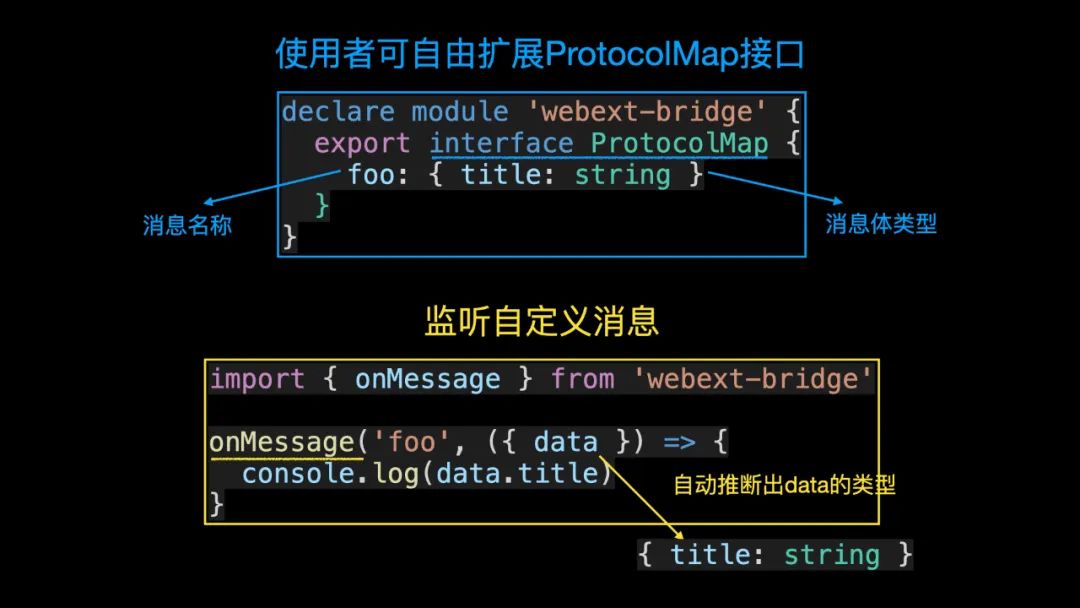大家好,我是若川。持续组织了8个月源码共读活动,感兴趣的可以 点此加我微信ruochuan12 参与,每周大家一起学习200行左右的源码,共同进步。同时极力推荐订阅我写的《学习源码整体架构系列》 包含20余篇源码文章。历史面试系列。另外:目前建有江西|湖南|湖北籍前端群,可加我微信进群。
阿宝哥精心准备的《轻松学 TypeScript》 视频教程已经更新到第十二期了,通过形象生动的动画,让你轻松搞懂 TypeScript 的难点和核心知识点!
如果你简历上的技能有写 TypeScript,那么面试官可能会问你 type 和 interface 之间有什么区别?你知道怎么回答这个问题么?如果不知道的话,那看完本文也许你就懂了。
类型别名 type 可以用来给一个类型起个新名字,当命名基本类型或联合类型等非对象类型时非常有用:
type MyNumber = number;
type StringOrNumber = string | number;
type Text = string | string[];
type Point = [number, number];
type Callback = (data: string) => void;在 TypeScript 1.6 版本,类型别名开始支持泛型。我们工作中常用的 Partial、Required、Pick、Record 和 Exclude 等工具类型都是以 type 方式来定义的。
// lib.es5.d.ts
type Partial<T> = {[P in keyof T]?: T[P];
};type Required<T> = {[P in keyof T]-?: T[P];
};type Pick<T, K extends keyof T> = {[P in K]: T[P];
};type Record<K extends keyof any, T> = {[P in K]: T;
};type Exclude<T, U> = T extends U ? never : T;而接口 interface 只能用于定义对象类型,Vue 3 中的 App 对象就是使用 interface 来定义的:
// packages/runtime-core/src/apiCreateApp.ts
export interface App<HostElement = any> {version: stringconfig: AppConfiguse(plugin: Plugin, ...options: any[]): thismixin(mixin: ComponentOptions): thiscomponent(name: string): Component | undefined // Gettercomponent(name: string, component: Component): this // Setterdirective(name: string): Directive | undefineddirective(name: string, directive: Directive): this
}由以上代码可知,在定义接口时,我们可以同时声明对象类型上的属性和方法。了解 type 和 interface 的作用之后,我们先来介绍一下它们的相似之处。
1、类型别名和接口都可以用来描述对象或函数
类型别名
type Point = {x: number;y: number;
};type SetPoint = (x: number, y: number) => void;在以上代码中,我们通过 type 关键字为对象字面量类型和函数类型分别取了一个别名,从而方便在其他地方使用这些类型。
接口
interface Point {x: number;y: number;
}interface SetPoint {(x: number, y: number): void;
}2、类型别名和接口都支持扩展
类型别名通过 &(交叉运算符)来扩展,而接口通过 extends 的方式来扩展。
类型别名扩展
type Animal = {name: string
}type Bear = Animal & { honey: boolean
}const bear: Bear = getBear()
bear.name
bear.honey接口扩展
interface Animal {name: string
}interface Bear extends Animal {honey: boolean
}此外,接口也可以通过 extends 来扩展类型别名定义的类型:
type Animal = {name: string
}interface Bear extends Animal {honey: boolean
}同样,类型别名也可以通过 &(交叉运算符)来扩展已定义的接口类型:
interface Animal {name: string
}type Bear = Animal & { honey: boolean
}了解完 type 和 interface 的相似之处之后,接下来我们来介绍它们之间的区别。
1、类型别名可以为基本类型、联合类型或元组类型定义别名,而接口不行
type MyNumber = number;
type StringOrNumber = string | number;
type Point = [number, number];2、同名接口会自动合并,而类型别名不会
同名接口合并
interface User {name: string;
}interface User {id: number;
}let user: User = { id: 666, name: "阿宝哥" };
user.id; // 666
user.name; // "阿宝哥"同名类型别名会冲突
type User = {name: string;
};// 标识符“User”重复。ts(2300)
type User = { //Errorid: number;
};利用同名接口自动合并的特性,在开发第三方库的时候,我们就可以为使用者提供更好的安全保障。比如 webext-bridge 这个库,使用 interface 定义了 ProtocolMap 接口,从而让使用者可自由地扩展 ProtocolMap 接口。
之后,在利用该库内部提供的 onMessage 函数监听自定义消息时,我们就可以推断出不同消息对应的消息体类型。
扩展 ProtocolMap 接口
import { ProtocolWithReturn } from 'webext-bridge'declare module 'webext-bridge' {export interface ProtocolMap {foo: { title: string }bar: ProtocolWithReturn<CustomDataType, CustomReturnType>}
}监听自定义消息
import { onMessage } from 'webext-bridge'onMessage('foo', ({ data }) => {// type of `data` will be `{ title: string }`console.log(data.title)
}
如果你感兴趣的话,可以看一下该项目的源码。若遇到问题,可以跟阿宝哥交流。最后我们来总结一下类型别名和接口的一些使用场景。
使用类型别名的场景:
定义基本类型的别名时,使用 type
定义元组类型时,使用 type
定义函数类型时,使用 type
定义联合类型时,使用 type
定义映射类型时,使用 type
使用接口的场景:
需要利用接口自动合并特性的时候,使用 interface
定义对象类型且无需使用 type 的时候,使用 interface

················· 若川简介 ·················
你好,我是若川,毕业于江西高校。现在是一名前端开发“工程师”。写有《学习源码整体架构系列》20余篇,在知乎、掘金收获超百万阅读。
从2014年起,每年都会写一篇年度总结,已经坚持写了8年,点击查看年度总结。
同时,最近组织了源码共读活动,帮助4000+前端人学会看源码。公众号愿景:帮助5年内前端人走向前列。

扫码加我微信 ruochuan02、拉你进源码共读群
今日话题
目前建有江西|湖南|湖北 籍 前端群,想进群的可以加我微信 ruochuan12 进群。分享、收藏、点赞、在看我的文章就是对我最大的支持~

)

















